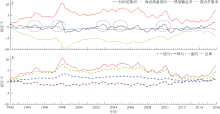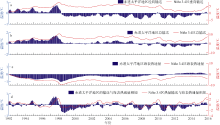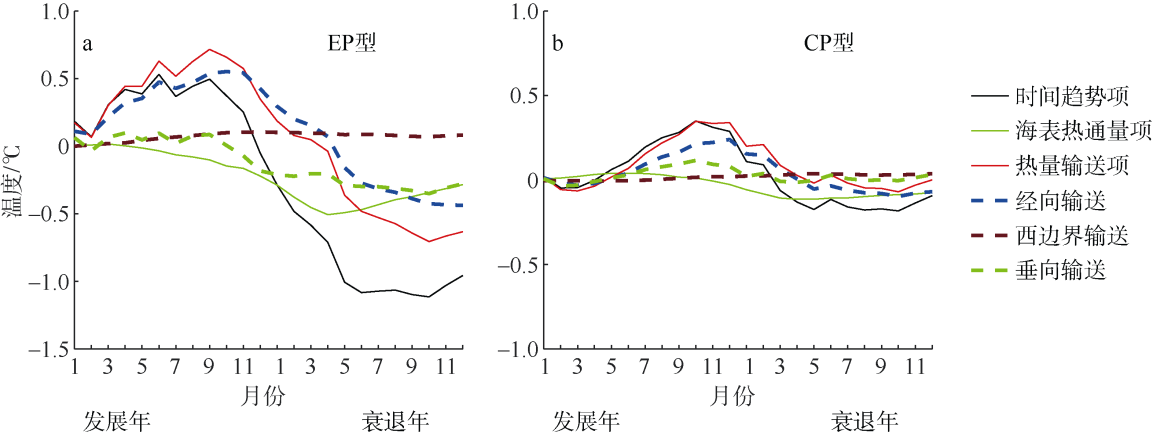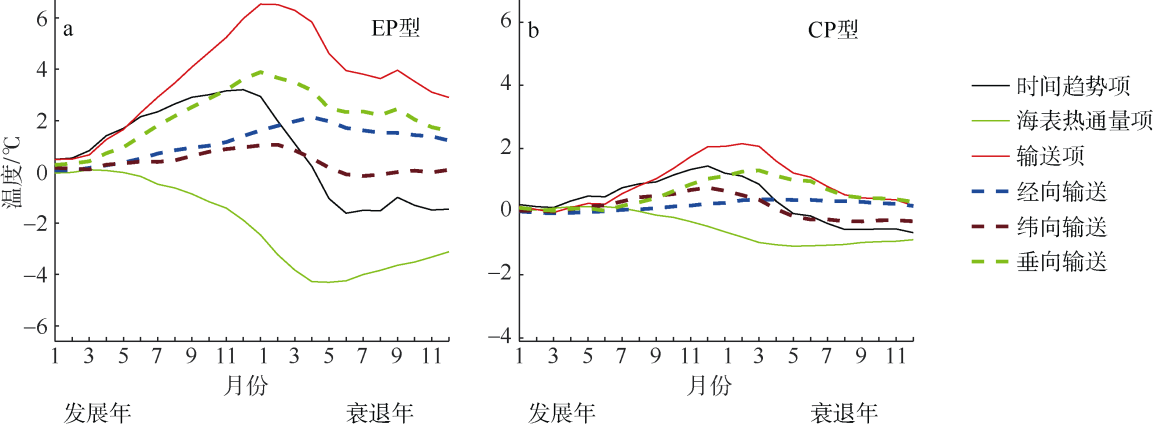| [1] |
陈永利, 赵永平, 张勐宁, 等, 2005. 赤道太平洋次表层海温异常年际和年代际变率特征与ENSO循环[J]. 海洋学报, 27(2): 39-45.
|
|
CHEN YONGLLI, ZHAO YONGPING, ZHANG MENGNING, et al, 2005. The characteristics of interannual and interdecadal variability of equatorial Pacific Ocean temperature anomalies and ENSO cycle[J]. Acta Oceanologica Sinica, 27(2): 39-45 (in Chinese with English abstract).
|
| [2] |
吴晓芬, 许建平, 张启龙, 等, 2011. 基于Argo资料的热带西太平洋上层热含量初步研究[J]. 海洋预报, 28(4): 76-86.
|
|
WU XIAOFEN, XU JIANPING, ZHANG QILONG, et al, 2011 A preliminary study on upper ocean heat content of tropical Western Pacific[J]. Marine Forecasts, 28(4): 76-86 (in Chinese with English abstract).
|
| [3] |
徐淑雯, 智协飞, 王晓春, 2016. 两类El Niño发生前期大气海洋状况的对比分析[J]. 热带气象学报, 32(5): 668-677.
|
|
XU SHUWEN, ZHI XIEFEI, WANG XIAOCHUN, 2016. Comparative analysis of atmospheric and oceanic conditions before the occurrence of two types of El Niño events[J]. Journal of Tropical Meteorology, 32(5): 668-677 (in Chinese with English abstract).
|
| [4] |
徐腾飞, 周慧, 2016. 海洋再分析资料中IOD-ENSO遥相关的海洋通道机制分析[J]. 海洋学报, 38(12): 23-35.
|
|
XU TENGFEI, ZHOU HUI, 2016. Oceanic channel dynamics of the IOD-ENSO teleconnection in oceanic reanalysis datasets[J]. Haiyang Xuebao, 38(12): 23-35 (in Chinese with English abstract).
|
| [5] |
BJERKNES J, 1969. Atmospheric teleconnections from the equatorial Pacific[J]. Monthly Weather Review, 97(3): 163-172.
|
| [6] |
BOWEN M, JORDAN M, SUTTON P, et al, 2016. Interannual variability of sea surface temperature in the Southwest Pacific and the Role of ocean dynamics[J]. Journal of Climate, 30(18): 7481-7492.
|
| [7] |
FORGET G, CAMPIN J M, HEIMBACH P, et al, 2015. ECCO version 4: an integrated framework for non-linear inverse modeling and global ocean state estimation[J]. Geoscientific Model Development Discussion, 8(5): 3653-3743.
|
| [8] |
HALPERN D, MENEMENLIS D, WANG XIAOCHUN, 2015. Impact of data assimilation on ECCO2 equatorial undercurrent and North Equatorial Countercurrent in the Pacific Ocean[J]. Journal of Atmospheric and Oceanic Technology, 32(1): 131-143.
|
| [9] |
HU DUNXIN, WU LIXIN, CAI WENJU, et al, 2015. Pacific western boundary currents and their roles in climate[J]. Nature, 552(7556): 299-308.
|
| [10] |
JIN FEIFEI, 1997. An equatorial ocean recharge paradigm for ENSO. Part I: conceptual model[J]. Journal of the Atmospheric Sciences, 54(7): 811-829.
|
| [11] |
KIM S B, FUKUMORI I, LEE T, 2006. The closure of the ocean mixed layer temperature budget using level-coordinate model fields[J]. Journal of Atmospheric and Oceanic Technology, 23(6): 840-853.
|
| [12] |
KIM S B, LEE T, FUKUMORI I, 2007. Mechanisms controlling the interannual variation of mixed Layer temperature averaged over the Nioñ-3 region[J]. Journal of Climate, 20(15): 3822-3843.
|
| [13] |
KUG J S, JIN FEIFEI, AN S I, 2009. Two types of El Niño events: cold tongue El Niño and warm pool El Niño[J]. Journal of Climate, 22(6): 1499-1515.
|
| [14] |
LEE T, FUKUMORI I, TANG BENYANG, 2004. Temperature advection: internal versus external processes[J]. Journal of Physical Oceanography, 34(8): 1936-1944.
|
| [15] |
LEE T, MICHAEL J M, 2010. Increasing intensity of El Nino in the central-equatorial Pacific[J]. Geophysical Research Letters, 37(14): L14603, doi: 10.1029/2010GL044007.
|
| [16] |
MEINEN C S, MCPHADEN M J, 2000. Observations of warm water volume changes in the equatorial pacific and their relationship to El Niño and La Niña[J]. Journal of Climate, 13(20): 3551-3559.
|
| [17] |
REN HONGLI, JIN FEIFEI, 2011. Niño indices for two types of ENSO[J]. Geophysical Research Letters, 38(4): L04704, doi: 10.1029/2010GL046031.
|
| [18] |
TAKAHASHI K, MONTECINOS A, GOUBANOVA K, et al, 2011. ENSO regimes: reinterpreting the canonical and Modoki El Niño[J]. Geophysical Research Letters, 38(10): L10707, doi: 10.1029/2011GL047364.
|
| [19] |
THOMPSON P R, PIECUCH C G, MERRIFIELD M A, et al, 2016. Forcing of recent decadal variability in the Equatorial and North Indian Ocean[J]. Journal of Geophysical Research, 121(9): 6762-6778.
|
| [20] |
WANG XIAOCHUN, JIN FEIFEI, WANG YUQING, 2003. A tropical ocean recharge mechanism for climate variability. Part II: a unified theory for decadal and ENSO modes[J]. Journal of Climate, 16(22): 3599-3616.
|
| [21] |
WYRTKI K, 1975. El Niño-the dynamic response of the equatorial Pacific Ocean to atmospheric forcing[J]. Journal of Physical Oceanography, 5(4): 572-584.
|
| [22] |
XIANG BAOQIANG, WANG BIN, LI T, 2013. A new paradigm for the predominance of standing Central Pacific Warming after the late 1990s[J]. Climate Dynamics, 41(2): 327-340.
|
| [23] |
YU JINYI, KAO H Y, LEE T, et al, 2011. Subsurface ocean temperature indices for central-pacific and eastern-pacific types of El Niño and La Niña events[J]. Theoretical and Applied Climatology, 103(3-4): 337-344.
|
| [24] |
ZEBIAK S, CANE M A, 1987. A model El Niño-southern oscillation[J]. Monthly Weather Review, 115(10): 2262-2278.
|
| [25] |
ZHANG YING, DU YAN, ZHANG YUHONG, et al, 2016. Asymmetry of upper ocean salinity response to the Indian Ocean dipole events as seen from ECCO simulation[J]. Acta Oceanologica Sinica, 35(7): 42-49.
|
 ), Xiaochun WANG1,2
), Xiaochun WANG1,2



















